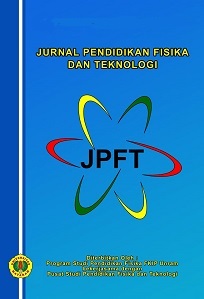Potential of Tebalan Shells from Tuban Beach as Active Material in Perovskite Solar Cells
DOI:
10.29303/jpft.v10i2.7700Published:
2024-12-24Issue:
Vol. 10 No. 2 (2024): July - DecemberKeywords:
Calcium Carbonate (CaCO3), Calcium Titanate (CaTiO3), Perovskite Solar Cell (PSC), Tebalan ShellArticles
Downloads
How to Cite
Downloads
Metrics
Abstract
One source of environmentally friendly renewable energy that has begun to be widely developed is PSC (Perovskite Solar Cell) made from natural ingredients. PSC is a new breakthrough strategic mineral processing technology as an alternative to silicon in the industry of solar power safety and stability. PSCs are easier to manufacture compared to silicon-based solar cells. The PSC material in this research is perovskite CaTiO3 which is made from the reaction between calcium carbonate (CaCO3) which is obtained from the Tebalan shell powder of Tuban beach and titanium dioxide (TiO2). The method used in this research is substrate preparation, synthesis of Perovskite CaTiO3, making TiO2 paste2, electrolyte solution preparation, counter electrode preparation, fabrication perovskite solar cell (PSC), as well as testing, characterization and data analysis. The tests and characterization that will be carried out are: Crystal structure of powdered materials used in making perovskite solar cells using XRD (X-ray Diffractometer) type X-Pert3 Powder, testing electric current with a potentiometer, and measuring light with a lux meter. The results of XRD testing on the calcined powder showed that the structure of calcium titanate perovskite (CaTiO3) was as much as 68.2%. Meanwhile, the characteristic values of the electrical properties of Tebalan clam shell perovskite solar cells from the lamp light source data obtained show that Vm and Im Daylight lamps have a greater value than warm white lamps and the efficiency value of the solar light source is highest when shown Air Mass 1.5, which is 0.000127%.
References
Chen, R., Cao, J., Duan, Y., Hui, Y., Chuong, T. T., Ou, D., Han, F., Cheng, F., Huang, X., Wu, B., & Zheng, N. (2019). High-efficiency, hysteresis-less, UV-stable perovskite solar cells with cascade ZnO–ZnS electron transport layer. Journal of the American Chemical Society, 141(2), 541–547. https://doi.org/10.1021/jacs.8b11001
Et-taya, L., Ouslimane, T., & Benami, A. (2020). Numerical analysis of earth-abundant Cu₂ZnSn(SₓSe₁₋ₓ)₄ solar cells based on spectroscopic ellipsometry results by using SCAPS-1D. Solar Energy, 201, 827–835. https://doi.org/10.1016/j.solener.2020.03.070
Handayani, L., & Syahputra, F. (2017). Isolasi dan karakterisasi nanokalsium dari cangkang tiram (Crassostrea gigas). Jurnal Pengolahan Hasil Perikanan Indonesia, 20(3), 515–523.
Hariyati, A. S., & Wibowo, M. A. (2019). Ekstraksi kalsium karbonat (CaCO₃) dari bahan dasar cangkang kerang ale-ale (Meretrix meretrix) pada temperatur kalsinasi 500°C. Jurnal Kimia Khatulistiwa, 8(1).
Herna, F. L., Tambunan, E. N. T., Meinarti, Y., & Rini, A. S. (2022). Perovskite solar cells yang stabil udara dan efisien menggunakan nanostruktur ZnO sebagai elektron transport material. Indonesian Physics Communication, 19(2), 75–82.
Hossain, M. A., Islam, M. S., Chowdhury, M. M. H., Sabuj, M. N. H., & Bari, M. S. (2011). Performance evaluation of 1.68 kWp DC operated solar pump with auto tracker using microcontroller-based data acquisition system. In Proceedings of the International Conference on Mechanical Engineering (pp. 1–5).
Kemal, G. I. (2020). Pengaruh variasi ketebalan calcium titanate terhadap performansi perovskite solar cell dengan simulasi SCAPS-1D (Disertasi doktoral). Universitas Brawijaya.
Lazzarin, M. (2023). The role of far-red light in plant photosynthesis and photoprotection under artificial solar irradiance (Disertasi doktoral). Wageningen University and Research.
Maulana, E., & Prakasa, M. A. (2021). Analisis pengaruh kecepatan putaran spin coating dengan bahan perovskite kalsium silikat terhadap kinerja perovskite solar cell. Jurnal EECCIS, 15(2), 49–55.
Mesquita, I., Andrade, L., & Mendes, A. (2018). Perovskite solar cells: Materials, configurations, and stability. Renewable and Sustainable Energy Reviews, 82, 2471–2489.
Puspita, E. (2018). Sintesis dan karakterisasi kalsium silikat berbahan dasar cangkang kerang darah pada suhu kalsinasi 1000°C.
Ramli, A. A., Ismail, A. K., Muhammad, R., & Hashim, M. F. (2022). A mini-review of recent studies on lead and lead-free perovskite materials for solar cells application and their issues. Jurnal Teknologi, 84(2), 135–146.
Torimtubun, A. A. A., Augusty, A. C., Maulana, E., & Ernawati, L. (2018). Affordable and sustainable new generation of solar cells: Calcium titanate (CaTiO₃)-based perovskite solar cells. In E3S Web of Conferences (Vol. 67, p. 01010). EDP Sciences. https://doi.org/10.1051/e3sconf/20186701010
Zein, M., & Riza, M. (2022). Rancang bangun pembangkit listrik tenaga surya di pos batas security PT. Gula Putih Mataram, Kabupaten Lampung Tengah. Jurnal Teknik Mesin Universitas Bandar Lampung, 9(1).
Author Biographies
Roihatur Rohmah, Universitas Nahdlatul Ulama Sunan Giri
Pelangi Eka Yuwita, Universitas Nahdlatul Ulama Sunan Giri
Prayoga Dewa Pangestu, Universitas Nahdlatul Ulama Sunan Giri
Erlangga Dwi Aprila Vibianto, Universitas Nahdlatul Ulama Sunan Giri
License
Copyright (c) 2024 Roihatur Rohmah, Pelangi Eka Yuwita, Prayoga Dewa Pangestu, Erlangga Dwi Aprila Vibianto

This work is licensed under a Creative Commons Attribution-ShareAlike 4.0 International License.
Authors who publish with Jurnal Pendidikan Fisika dan Teknologi (JPFT) agree to the following terms:
- Authors retain copyright and grant the journal right of first publication with the work simultaneously licensed under a Creative Commons Attribution License 4.0 International License (CC-BY-SA License). This license allows authors to use all articles, data sets, graphics, and appendices in data mining applications, search engines, web sites, blogs, and other platforms by providing an appropriate reference. The journal allows the author(s) to hold the copyright without restrictions and will retain publishing rights without restrictions.
- Authors are able to enter into separate, additional contractual arrangements for the non-exclusive distribution of the journal's published version of the work (e.g., post it to an institutional repository or publish it in a book), with an acknowledgement of its initial publication in Jurnal Pendidikan Fisika dan Teknologi (JPFT).
- Authors are permitted and encouraged to post their work online (e.g., in institutional repositories or on their website) prior to and during the submission process, as it can lead to productive exchanges, as well as earlier and greater citation of published work (See The Effect of Open Access).











